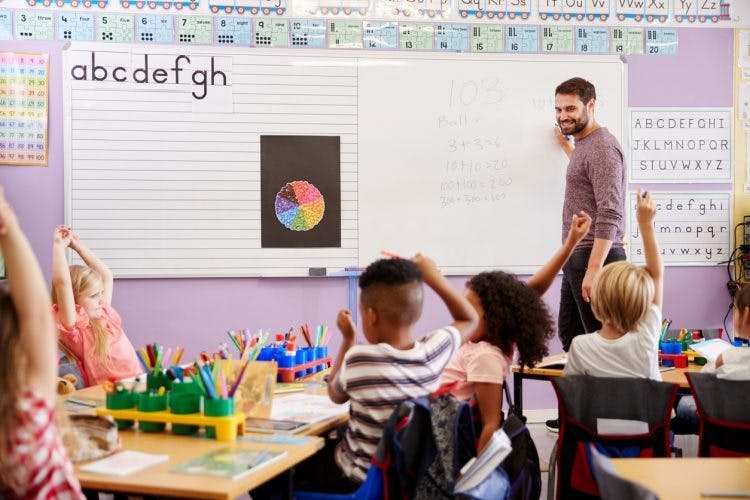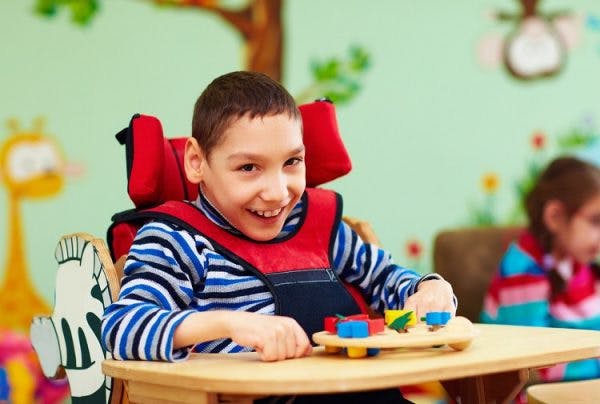Wondering what you can do to support and accommodate a student with cerebral palsy in the classroom?
This article will help you understand what cerebral palsy is and how to help a student with CP succeed academically.
Understanding Cerebral Palsy
Cerebral palsy is a spectrum disorder, meaning that individuals can demonstrate a wide range of symptoms at varying severities. Therefore, classroom accommodations should be different for each child.
In fact, not all children with cerebral palsy will need accommodations. Cerebral palsy is a motor disorder, meaning that it affects an individual’s movements, balance, posture, and coordination.
While all children with cerebral palsy have motor impairments, the severity and locations of their motor impairments will vary from person to person. Some are able to walk independently, while others need the assistance of a wheelchair, crutches, or a walker.
If cerebral palsy affects the hands, individuals may struggle with fine motor tasks like writing. Likewise, if cerebral palsy affects the oral muscles, individuals may be non-verbal.
Children with cerebral palsy can exhibit a wide range of associative conditions. These are conditions that are not directly related to CP but often co-occur. Associative conditions of CP include:
Generally, the milder a child’s cerebral palsy is, the easier it will be for them to integrate into an inclusive classroom. However, with the right support, children with more severe forms of cerebral palsy can also succeed in school.
In the following section, we’ll discuss what accommodations can help children with cerebral palsy maximize their potential at school.
Want 19 pages of CP recovery tips in PDF form? Click here to download our free illustrated ebook now (link opens a pop up for uninterrupted reading)
Accommodations for Students with Cerebral Palsy
The Americans with Disabilities Act (ADA) “prohibits discrimination on the basis of disability in employment, state and local government, public accommodations, commercial facilities, transportation, and telecommunications.”
This means that reasonable accommodations must be made to help students with disabilities succeed in the classroom and participate in activities and events. It’s essential to create an environment that promotes success in the classroom for everyone.
Accommodations will vary depending on the individual needs of the student. Some common accommodations for children with disabilities include:
- allowing additional time to finish assignments
- providing adaptive tools
- making sure the classroom is wheelchair accessible
- adjusting the formatting of tasks and assignments (taking a written test verbally, allowing the student to type their answers, etc,)
- taking advantage of alternative communication (iPads, speech-generating devices, etc.)
- having an aide (for physical assistance, or reading and writing support)
Up next, we’ll discuss what steps a teacher can take to support a student with cerebral palsy.
How to Support a Child with Cerebral Palsy in the Classroom
With the right support, children with cerebral palsy can excel in the same classroom as children without disabilities.
Below, we’ll discuss 3 steps for helping students with cerebral palsy succeed in the classroom:
1) Develop an Individualized Education Program (IEP)
An Individualized Education Program (IEP) is a written document created for public school students with special needs. It outlines their specific accommodations, goals, and progress.
Ensuring the success of a student with cerebral palsy in mainstream schooling requires a collaborative effort between the parents, teachers, school administrators, and ancillary staff. They must come together to discuss the child’s unique needs and determine what kinds of supports and services can help them succeed in the classroom.
Accommodations can also be provided to increase participation in activities outside of the classroom, such as allowing extra time to navigate hallways and having appropriate utensils for mealtimes. These accommodations, supports, and services should be written in the IEP and distributed to all the individuals involved.
Learn more about developing an IEP »
2) Frequently Communicate with the Student’s Parents

Frequent communication with the student’s parents is essential. They can offer insight into their child’s interests and what strategies work best for them at home. By learning about the student’s strengths, weaknesses, and triggers, teachers and administrators can improve the child’s learning experience.
Additionally, parents need to know how their child is doing when they’re not around. Are they getting along with others? Do they get easily frustrated by schoolwork?
By communicating these problems, both teachers and parents can work to resolve behavioral problems at school and home.
3) Focus on Inclusion
A sense of belonging can also positively affect a student’s performance in the classroom. Inclusion is about focusing on a student’s ability rather than their disability.
Some ways to help students feel more included in the classroom include:
- Organizing small group discussions. Not all children are comfortable speaking in front of the entire class. Small groups help relieve the pressure and allow each student to voice their opinion.
- Speaking to the student privately. It’s a good idea to check in on the student every now and then to discuss how they feel in the classroom and whether further accommodations are needed.
- Acknowledging their efforts and improvements. Whether it’s laughing at a joke or providing positive feedback on an assignment, acknowledging the student’s efforts can encourage them to keep up the good work.
When children feel safe and accepted in their environment, they’re more likely to participate and ask for help.
Supporting Individuals with Cerebral Palsy in the Classroom
Cerebral palsy affects movements, so students with CP may need extra space, time, and support to get around the classroom and complete assignments.
While their motor impairments may make it difficult for them to write, move around, or speak, most children with CP have average or above-average intelligence and are perfectly capable of learning.
We hope this article helped you understand how to help a child with cerebral palsy succeed in the classroom.











